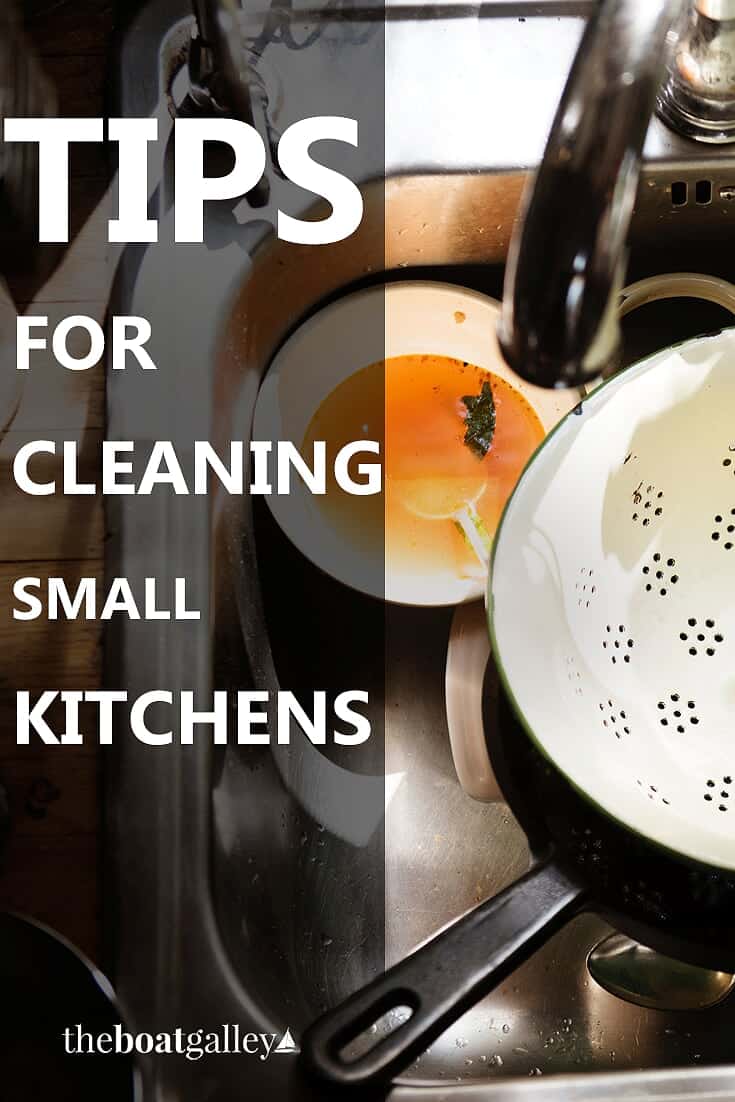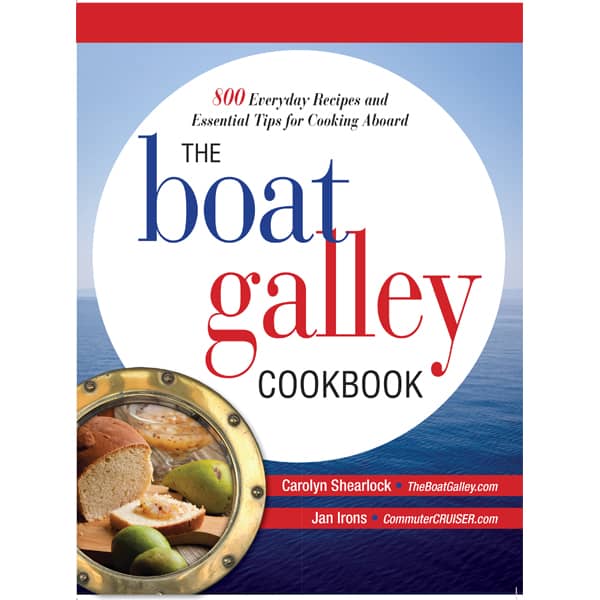Okay, we’ll start with the fact that cleaning up is about my least favorite part of any job. In the galley, I’d much rather be doing the cooking . . . and the eating. But when we informally divided up the chores, I got cleaning the dishes. Dave got cleaning fish. Considering that I really hate cleaning fish, I was reasonably happy with the split.
Now that I’ve discovered these six tools, I’m definitely happy with the division of labor. Cleaning up isn’t nearly the chore it used to be.
- Silicone Spoon Spatula — in addition to lots of cooking duties, I use it to scrape plates and pans before washing them. The shape just plain works far better than a rubber scraper, it’s stiffer and gets more off, and the seamless construction makes it easy to clean. Scrape the dishes into a wide-mouth jar so as not to attract bugs . . . or have a stinky trash can!
- Scrubr dish rag — it’s got enough “grit” to get dishes clean but won’t harm non-stick finishes. But the best thing about it is that it just never gets stinky . . . and that means that my hands don’t get that nasty smell, either.
- Nail brush — it’s a mini scrub brush that I use a lot, particularly on plastic containers.
- Bottle brush — in many stores, you won’t find one in housewares . . . they’re in infants. The perfect tool to scrub out a Thermos or water bottle. Also great for cleaning the gap between the stove and the counter without totally removing the stove.
- Q-tips — they get in places where lots of other tools can’t, particularly the joint where the counter meets the lip. “Gunk” always seems to collect here.
- Denture tablets — tough on stuck-on food, whether in a pan or Thermos. Just toss a few denture tablets in with a bit of water, let the pan sit overnight and then a tiny bit of rubbing will get rid of pretty much anything. Much easier than scrubbing with Brillo (which just turns into a rusty pad if you’re around salty air)!
- Update — had to add a seventh — a bent toothbrush! Learn how to bend one here.

Carolyn Shearlock has lived aboard full-time for 17 years, splitting her time between a Tayana 37 monohull and a Gemini 105 catamaran. She’s cruised over 14,000 miles, from Pacific Mexico and Central America to Florida and the Bahamas, gaining firsthand experience with the joys and challenges of life on the water.
Through The Boat Galley, Carolyn has helped thousands of people explore, prepare for, and enjoy life afloat. She shares her expertise as an instructor at Cruisers University, in leading boating publications, and through her bestselling book, The Boat Galley Cookbook. She is passionate about helping others embark on their liveaboard journey—making life on the water simpler, safer, and more enjoyable.
Simplify meal prep on board with proven strategies for provisioning, maximizing fridge space, and cooking delicious meals aboard your boat.











Sara Peterson says
Hi Carolyn : )
I have been taking my pot(s) that have any type of residue that I have not been able to ‘scrape’ out and adding about 1/2″ of water to the pan. Then I turn the heat up on the pan and after the water gets hot, I use my scrubby rag to loosen the debris. I pour the water through a strainer into a lidded jar that I add some Dawn to and use it the next time too. It is usually good for a week or so and I keep it under the sink with my vinegar and other tools. The strainer gets cleaned out in the glass garbagae container. It has a seal tight lid. It gets emptied with the trash depending upon how long we are out.
Mark says
For cookie sheets, pot, and pans that are going to be hard to clean, my wife puts a dryer sheet and enough water for it to float in. Let it sit a few hours or over night if it’s really caked on, and the stuff just slides right off.
Karen Bowen says
I keep toothbrushes in the galley! By applying heat, usually from a candle, the handle will soften then can be bent to allow the head of the brush to be set at an angle. I have created a variety of angles which allows me to easily reach into those nooks and crannies where gunk accumulates. We also created a set for the tool box since my kitchen ones kept disappearing only to reappear there.
Diane Dashevsky sv/Always $umthing says
I have noticed that most galleys have stainless steel sinks – like ours. When your hands get stinky from seafood, stinky rags, etc…just rub your hands on the side of the sink…bye bye stinky!
Cream of Tartar used as a bit of scouring powder will also get baked-on crud off pots, etc. My grandmother’s trick 🙂
Jan Alexander says
I keep a sewing needle in the galley and usually use the blunt end for scraping gunk out of tiny nooks, like around the outside rims of Tupperware type containers, around handles of pots and pans, etc.
The Boat Galley says
Great idea Jan!
Jarrod Garritson says
Where is the miracle eraser?
The Boat Galley says
I don’t use it all that much — it’s like using really fine wet sandpaper and I don’t like to take the finish off!
Jarrod Garritson says
Yeah. Good point. they are amazing at taking off old stains on counters (main reason I use them).
desiree says
Wow! What a great read! Something that I also like a lot for small spaces to use in conjunction with Q tips are long wooden skewers for bbq or just normal toothpicks
Elaine says
I’ve discovered that the brushes used to clean dentures also make a great tool for cleaning. Large brush on one side, small on the other with a rubber tip on the end for those really small, stubborn spots.
Ralph says
Very good!
Items like the coffee basket are especially difficult because of the corners and fins, and you can’t reach them with a normal toothbrush.
Two more brush options:
1. In Mexico, in the stores/supermarkets you can find small brushes in which the bristles stick straight out the end, same direction as the handle itself- “axial” alignment. They can reach into these kinds of crevices better. Cheap. Can’t find them in the U.S.All stores sell the same limited junk. Hard to even find a Good bottle brush.
There is also a similar brush made of plant fiber. It’s very stiff, ok for hard scrubbing, but too stiff for coffee basket use.
2. In auto parts stores, you can find a “parts brush”. Its bristles are aligned like above, but they’re very close together. The brushes in 1. are usually better. The parts brush is made for cleaning auto parts in solvent when working on an engine.
Tami says
I get stainless scouring scrubbers from the Asian markets for .50-$1.00 each and they don’t rust
Jacqui Pfaff says
I just love your page and website.
The Boat Galley says
Thank you!
Becky says
My husband ordered “fish and chip” baskets online, plus the checkered paper liners for them. Inexpensive, and I cut the paper to fit our plates, so we can have strong plates (instead of wimpy paper plates) and then just fold and toss the paper liners. Saves us a lot on dish washing, since we’re throwing away the stuff that would have stuck to the plate itself. — Garbage is not an issue nor are bugs in the NW (Wa., Can.,Alaska.)
Molly S/V Sabai says
I love the Novatek scrubby rags Carolyn recommends. I also like are the prickly little silicone “sponges.” Like the Novatek scrubbers they never get stinky but they won’t harm your plastic glassware.
Jackie (dirt-dweller now, but we did own SV Lively Lady) says
I use an expired credit/gift card as a scraper. They are strong, have curved corners, won’t scratch non-stick finishes and are free! I still use it even though we’re not on the boat!